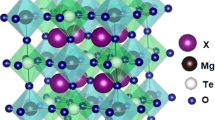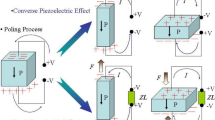Abstract
We present a review of papers published in the last five years devoted to the investigation of the state of impurities and their influence on piezoelectric materials based on lead zirconium titanium oxide (PZT). We have determined for the first time the characteristics of impurity charge states, their excess charge compensation and position in ceramic grains or in the intergranular space for different types of impurities and concentrations. Study of electron paramagnetic resonance spectra made it possible to suggest a sensitive nondestructive method for monitoring the boundaries of the morphotropic region of piezoceramic PZT, which is of great importance for improving the technology and lowering the cost of production for this material.
Similar content being viewed by others
References
J. C. Burfoot and G. W. Taylor, Polar Dielectrics and Their Applications [Russian translation], Mir, Moscow (1981).
B. Jaffe, W. R. Cook, and H. Jaffe, Piezoelectric Ceramics [Russian translation], Mir, Moscow (1974).
E. G. Fesenko, A. Ya. Dantsiger, and O. I. Razumovskaya, New Piezoceramic Materials [in Russian], Izdat. Rostov. Univ., Rostov (1983).
S. A. Al'tshuler and B. M. Kozyrev, Electron Paramagnetic Resonance [in Russian], Nauka, Moscow (1972).
M. D. Glinchuk, V. G. Grachev, M. F. Deigen, et al., Electrical Effects in RF Spectroscopy [in Russian], Nauka, Moscow (1981).
A. Abragam and B. Bleaney, Electron Paramagnetic Resonance of Transition Ions [Russian translation], Mir, Moscow (1973).
J. E. Wertz and J. R. Bolton, Electron Spin Resonance: Elementary Theory and Practical Applications [Russian translation], Mir, Moscow.
M. E. Lines and A. M. Glass, Principles and Applications of Ferroelectrics and Related Materials [Russian translation], Mir, Moscow.
A. Barbulescu, E. Barbulescu, and D. Barb, “Phase transitions in PZT solid solutions,” Ferroelectrics,47, 221–230 (1983).
M. J. Haun, E. Furman, S. J. Jang, and L. E. Cross, “Thermodynamic theory of the lead zirconate—titanate solid solution system. I. Phenomenology,” Ferroelectrics,99, 13–25 (1989).
R. W. Whatmore and A. M. Glazer, “Structural phase transitions in lead zirconate,” J. Phys. C: Solid State Phys.,12, 1505–1512 (1979).
M. D. Glinchuk, V. I. Trefilov, and Yu. I. Yakimenko, “Ferroelectric materials and their use in technology,” Visn. Akad. Nauk Ukraini, No. 2 (1987).
V. G. Gavrilyachenko, R. I. Spinko, M. A. Martynenko, and E. G. Fesenko, “Spontaneous polarization and coercive field of lead titanate,” Fiz. Tverd. Tela,12, 1532–1534 (1970).
L. M. Sheppard, “Many new and exotic materials are emerging from the research labs for electronic and optical applications,” New Ceramics on the Horizon,29, No. 7, 23–28 (1984).
Optical Technician's Handbook [in Russian], Leningrad (1983).
D. Vieland, J. F. Li, S. J. Jang, and L. E. Cross, “Glassy polarization behavior of relaxor ferroelectrics,” Phys. Rev. B.,46, No. 13, 8013–8016 (1992).
V. I. Dimza, A. A. Sprogis, A. E. Kapenieks, et al., “Structure and dielectric and optical properties of (Mn, Fe, Co, Eu)-doped PLZT ceramics,” Ferroelectrics,90, 45–55 (1989).
I. P. Bykov, M. D. Glinchuk, V. G. Grachev, et al., “Investigation of paramagnetic centers of titanium and chromium in solid solutions based on lead zirconate—titanate,” Fiz. Tverd. Tela,33, No. 12, 3459–3464 (1991).
I. P. Bykov, M. D. Glinchuk, V. V. Laguta, et al., “Investigation of chromium impurities' charge state and chemical bonds in PLZT ceramics,” J. Phys. Chem. Sol.,56, No. 7, 919–923 (1995).
A. Abragam, Nuclear Magnetic Resonance [Russian translation], Mir, Moscow (1962).
M. D. Glinchuk, I. P. Bykov, and V. V. Laguta, “Dynamic of Nb ions in PMN diffused phase transition region and its NMR investigation,” Ferroelectrics,143, 39–47 (1993).
V. Dimza, P. Paulins, M. S. Zhang, et al., “Studies of Raman scattering spectra (RSS) of PLZT and PMN ceramic doped with 3d elements,” Ferroelectrics,127, 150–159 (1992).
M. D. Glinchuk and V. A. Stephanovich, “Random fields and their influence on the phase transitions in disordered ferroelectrics,” J. Phys.: Condens. Matter,6, 6317–6327 (1994).
I. P. Bykov, M. D. Glinchuk, and V. V. Skorokhod, “Study of mechanisms for compensation of excess charges of impurities in PbZr1−xTixO3 ceramic by EPR,” Fiz. Tverd. Tela,84, No. 5, 1343–1348 (1992).
I. P. Bykov, M. D. Glinchuk, V. V. Skorokhod, et al., “The charge state of Mn, Ti and Cr ions and its influence on the properties of lead titanate—zirconate solid solutions,” Ferroelectrics,127, 89–94 (1992).
M. D. Glinchuk, I. P. Bykov, V. M. Kurliand, et al., “Valency states and distribution of manganese ions in PZT ceramics simultaneously doped with Mn and Nb,” Phys. Stat. Sol. (a),122, 341–346 (1990).
M. D. Glinchuk, I. P. Bykov, V. V. Skorokhod, and T. Kala, “The influence of manganese admixture on the properties of PLZT ceramics,” Ferroelectrics,131, 233–237 (1992).
V. Dimza, Tong-Zheng Jing, Shi-Ying Han et al., “EPR study of manganese-doped PLZT 8/65/35 ceramics,” Phys. Stat. Sol. (a),132, K93-K95 (1992).
V. Dimza, Tong-Zheng Jing, Shi-Ying Han, et al., “EPR study of manganese-doped PLZT 8/65/35 ceramics,” Phys. Stat. Sol. (a),132, K93-K95 (1992).
V. Trepakov, V. Dimza, L. Jastrabik, et al., “Luminescence and optical absorption in nominally pure and Cr-doped PLZT ceramics,” Phys. Stat. Sol. (b),183, 299–307 (1994).
Additional information
Institute of Problems of Materials Science, National Academy of Sciences of Ukraine, Kiev. Translated from Poroshkovaya Metallurgiya, Nos. 7/8(380), pp. 11–24, July–August, 1995.
Rights and permissions
About this article
Cite this article
Glinchuk, M.D. Piezoceramic materials based on lead zirconate-titanate solid solutions (review). Powder Metall Met Ceram 34, 352–362 (1996). https://doi.org/10.1007/BF00559428
Issue Date:
DOI: https://doi.org/10.1007/BF00559428




